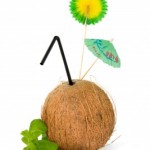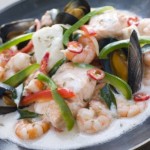By Catharine L. Kaufman—a.k.a. The Kitchen Shrink
 The Marx Brothers made “coconuts” a funny word but even without that reference, we might be tempted to snicker at the sight of these hairy brown spheres for their imagined, carved or painted resemblance to cavemen or Amazonian shrunken heads.
The Marx Brothers made “coconuts” a funny word but even without that reference, we might be tempted to snicker at the sight of these hairy brown spheres for their imagined, carved or painted resemblance to cavemen or Amazonian shrunken heads.
Giggles, however, quickly turn into lip-smacking at the first sip of the deceptively watery but sweet and nourishing coconut ‘milk’ or bite of crunchy white ‘meat’ contained within that unattractive exterior. Both milk and meat are versatile in their uses—such as cooking oil, flaky additions to trail-mix snacks, ingredients in traditional Thai dishes, cakes, cookies, piña coladas and other foods, as well as oily infusions in sunscreens, soaps and toiletries of all sorts.
Health Caveat: The jury is still out on the health benefits versus dangers or limitations of ingesting coconut products either in foods or through the skin, in lotions, since it is one of the few plants that contain potentially artery-clogging saturated fats high in cholesterol. Contradictory reports by various medical and nutrition researchers range from warnings about coconut fat causing elevated levels of LDL (bad cholesterol) and a danger to people with cardio-vascular issues, to recommending the product as a safe and healthy alternative to animal fats.
In his book, Coconut Cures, Bruce Fife maintains that lauric acid, which comprises about half the fatty acids in coconut oil, has been linked to raising HDL (good cholesterol) levels and thus, by improving the cholesterol ratio, actually reducing the risk of heart disease.
Recently, more reports have been popping up, praising not just the oil, but the meat, milk and water as healthy, often medicinal food that has been shown to dissolve kidney stones, improve thyroid function, kill disease-causing bacteria, viruses and fungi, increase energy and speed up metabolism. High in fiber content, the coconut is also said to help the absorption of fat-soluble vitamins and minerals.
Dr. Carolyn Mein, a renowned chiropractor whose Rancho Santa Fe, CA practice has been serving patients for more than 25 years, recommends Tropical Traditions Virgin Coconut Oil for cooking since it has a high flash point and doesn’t burn, as well as for drizzling on steamed veggies and seafood, instead of butter. Dr. Mein is especially pleased by the healthy effect this oil has on her patients’ skin and hair.
The Multi-Use Marvel: In the right hands, every part of the coconut can be used, with none of it wasted. Outer fibers that wrap and cushion its shell are woven into textiles, mats and garments, often tinted with dyes derived from the juicier strands. Symmetrically split and cleanly hollowed shells are turned into bowls, decorative items, furniture parts, artworks and, of course, the ubiquitous brassieres worn by hula dancers and other exotic performers. Even broken fragments are fashioned into eating and serving utensils.
In fact, the entire coconut plant is pressed into service by consumers, industries and artisans in such forms as:
• Palm sugar from the sap and nectar of coconut trees is turned into a caramel-flavored
replacement for brown sugar or molasses in cooking and baking.
• Copra is the dried and shredded ‘meat’ used in baked goods and confections, while grated and pressed raw copra is the source of coconut milk.
• More coconut oil is produced today than olive oil, due to its four-decade-long and continuing popularity as a misnamed ‘vegetable’ oil. Although it has recently been outdistanced in production and sales by the less expensive soy oil.
• Immune-boosting qualities have been discovered in the refreshing watery ‘milk’ of immature coconuts.
• Coir fiber from coconut husks makes potting mixes, rope, matting, fuel and automotive parts.
Everything You (May Or May Not Have) Wanted To Know About Coconuts: First, it is neither a nut nor a fruit, but an amazingly mobile, adaptable, nearly indestructible, self-contained seed capable of sprouting a tree even in distant, inhospitable soils. The plant’s origins are shrouded in mystery. Although botanists have not yet been able to nail down the exact genetic provenance of the coconut palm, they believe it originated somewhere between the eastern Indian and western Pacific Oceans near New Guinea.
This remarkable seed’s mobility is facilitated by its light weight, compact size, easy to roll spherical shape and impermeable (and thus unsinkable) hull. The same attributes make it portable by animals and humans and prone to rolling into waterways on which they float and are carried over great distances. Which is how coconuts might have spread to Africa, various island archipelagos and other shores,
Killer Coconuts: There have been about 150 deaths reported each year worldwide from falling
coconuts. But whether these numbers are accurate or not, there is no doubt that the danger of sustaining a cracked skull, concussion or other injury when standing near a coconut fall zone is quite real. Since the trees are typically 25 meters high, and the ripe seed averages 3 kilograms—increased by its falling velocity to around 1,000 kilograms—it is advisable to avoid standing, sitting or lounging anywhere near—or even attempting to climb—a coconut tree. Leave the latter to the pros.
From My Travels—A Mouthwatering Recipe: Discovering new flavors is one of my great pleasures while away from home. During my globetrotting days, on a trip to Cartagena, Colombia, I fell in love with a traditional dish called Arroz Con Coco, a divine coconut rice pudding so delicious that just reading the recipe below will make your mouth water:
Arroz Con Coco
3 cups water
1 cup short grain rice like Arborio
1 can sweetened condensed milk
½ cup evaporated milk
½ cup coconut milk
½ cup golden raisins
¼ teaspoon vanilla extract
1 tablespoon crystallized ginger, chopped
1 teaspoon lemon zest
1/2 teaspoon cinnamon
Dash of salt
Toasted shredded coconut and lemon zest
In a medium saucepan, combine the water, rice, vanilla extract and cinnamon. Bring to a boil on medium heat, then simmer, stirring constantly. Reduce heat to low, and continue stirring until the rice is tender or the water is absorbed. Add the milks and raisins and cook for another 10 minutes. Blend in the ginger, zest and salt and cook for 5 more minutes. Spoon into champagne flutes or margarita glasses, sprinkle with shredded coconut and zest. Chill and serve.
(For your coconut comments email Catharine directly at: [email protected] or send us a comment at [email protected] and indicate your permission to post it with this column on www.FreeRangeClub.com.)



